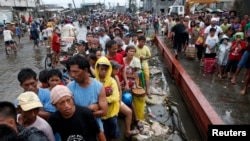WASHINGTON —
The World Bank is considering increasing cash grants for the poor in the Philippines after the island nation was hit by a devastating typhoon at the weekend.
The development lender provides such grants via the Philippine government to encourage the country's poorest people to send their children to school and check their health.
The bank is now discussing with the government whether to increase the speed and volume of the transfers after Typhoon Haiyan, or to remove conditions placed on them, World Bank President Jim Yong Kim told a news briefing on Tuesday.
“We've made clear to the authorities in the Philippines that we'd be prepared to be involved in any way that they find appropriate,” Kim said. He added that the bank could also consider assisting in the removal of some of the debris from the storm, as it did after the earthquake in Haiti.
Philippine officials have been overwhelmed by Haiyan, one of the strongest typhoons on record. It tore through the central Philippines on Friday and flattened Tacloban, coastal capital of Leyte province.
On Tuesday, President Benigno Aquino estimated the death toll at 2,000 to 2,500. Many of those who died drowned in a tsunami-like wall of seawater.
Kim said the typhoon should bring to the forefront the devastation that is likely to accompany climate change, as the number and frequency of storms and droughts increases around the world.
“The critical issue is that you cannot connect any single event to climate change,” he said.
“That's not the point... . The real event is that the frequency of these events is increasing, and that's exactly what the climate-change scientists have predicted.”
The United Nations Intergovernmental Panel on Climate Change (IPCC) has said it is “more likely than not” that storms will increase in intensity in the coming century.
The World Bank has increased its focus on climate change since Kim took office last year, publishing several reports about the effects of a warmer world. Kim argues that climate change will hit the world's poorest the hardest.
The priority for the Philippines should be to increase its resilience to future weather shocks, Kim said, adding that the World Bank had done analysis on how much it would cost to create levies, barriers and other measures to reduce the impact of storms.
The cost of major storms in terms of damage to coastlines worldwide is currently about $6 billion a year, but this could increase to $1 trillion a year by 2050, in inflation-adjusted terms, due to the impact of climate change, Kim said.
Investing about $50 billion a year globally on building resilience could avoid most costs in the future, he said.
“It's going to be very expensive, but compared to what it will cost if we don't do it, we think it's a good investment,” he said, adding that the World Bank was working with governments to assist poorer countries with the investments.
The development lender provides such grants via the Philippine government to encourage the country's poorest people to send their children to school and check their health.
The bank is now discussing with the government whether to increase the speed and volume of the transfers after Typhoon Haiyan, or to remove conditions placed on them, World Bank President Jim Yong Kim told a news briefing on Tuesday.
“We've made clear to the authorities in the Philippines that we'd be prepared to be involved in any way that they find appropriate,” Kim said. He added that the bank could also consider assisting in the removal of some of the debris from the storm, as it did after the earthquake in Haiti.
Philippine officials have been overwhelmed by Haiyan, one of the strongest typhoons on record. It tore through the central Philippines on Friday and flattened Tacloban, coastal capital of Leyte province.
On Tuesday, President Benigno Aquino estimated the death toll at 2,000 to 2,500. Many of those who died drowned in a tsunami-like wall of seawater.
Kim said the typhoon should bring to the forefront the devastation that is likely to accompany climate change, as the number and frequency of storms and droughts increases around the world.
“The critical issue is that you cannot connect any single event to climate change,” he said.
“That's not the point... . The real event is that the frequency of these events is increasing, and that's exactly what the climate-change scientists have predicted.”
The United Nations Intergovernmental Panel on Climate Change (IPCC) has said it is “more likely than not” that storms will increase in intensity in the coming century.
The World Bank has increased its focus on climate change since Kim took office last year, publishing several reports about the effects of a warmer world. Kim argues that climate change will hit the world's poorest the hardest.
The priority for the Philippines should be to increase its resilience to future weather shocks, Kim said, adding that the World Bank had done analysis on how much it would cost to create levies, barriers and other measures to reduce the impact of storms.
The cost of major storms in terms of damage to coastlines worldwide is currently about $6 billion a year, but this could increase to $1 trillion a year by 2050, in inflation-adjusted terms, due to the impact of climate change, Kim said.
Investing about $50 billion a year globally on building resilience could avoid most costs in the future, he said.
“It's going to be very expensive, but compared to what it will cost if we don't do it, we think it's a good investment,” he said, adding that the World Bank was working with governments to assist poorer countries with the investments.







